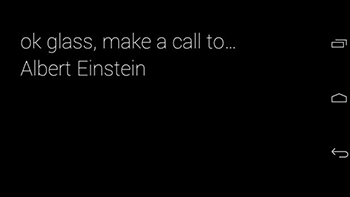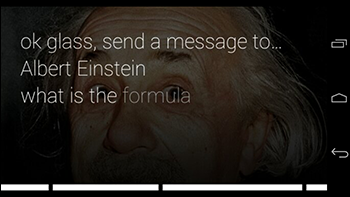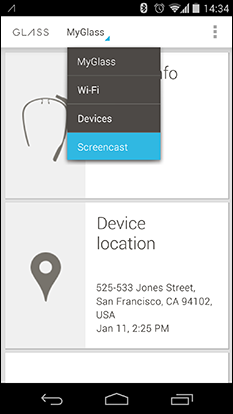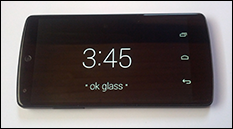Chapter 10
Using Glass with Your Phone
In This Chapter
![]() Making and receiving calls
Making and receiving calls
![]() Exchanging messages with friends
Exchanging messages with friends
![]() Sharing your screen live
Sharing your screen live
![]() Controlling your Glass remotely
Controlling your Glass remotely
To me, e-mails are a little bit frustrating. I think that the telephone is much preferred because you get the sound of the voice and the interest and everything else you can’t see in an e-mail.
— T. Boone Pickens
Glass doesn’t have a phone incorporated into its hardware — at least, not in the first version of the device — so it relies on any smartphone that allows you to make Bluetooth connections. When you connect your smartphone and your Glass, you’ll be able to place calls by speaking into Glass and also receive calls over your hands-free handset.
If your contact has a phone number, and you want to send a message to that person, Glass sends a Short Message Service (SMS) message to the person’s smartphone or tablet. The SMS service works with your Android smartphone so you can tell Glass to dictate a message to a specific contact. When you send that message, it appears in the contact’s messaging app on his smartphone.
Finally, the MyGlass app available on smartphones comes with a nifty feature called screencasting, which allows you to project what’s happening on the Glass screen to a projector or a smartphone. You can even use the MyGlass app to control Glass from your smartphone while you’re screencasting, which is useful for explaining how to navigate on Glass to your audience.
Making and Taking Phone Calls
The benefit of using Glass as a headset for making and receiving calls is that you don’t have to fumble for your phone in your pocket and then keep looking down at your phone or holding the phone to your head to converse with someone. Instead, Glass gives you the freedom to make and receive calls hands-free.
Opening a channel
It’s easy to make a call. Just say “OK Glass, make a call to…” followed by the name of the person in the Glass contact database whom you want to call. If you say “OK Glass, make a call to Albert Einstein,” you see the call screen shown in Figure 10-1.

Figure 10-1: Calling a world-famous scientist.
Captain, you’re being hailed
When you receive a phone call, Glass plays a rising and falling chime on its speaker and then displays the name and phone number of the person who’s calling you.
To accept the call, do either of the following:
- Tap the touchpad and choose Accept from the menu.
- Say “OK Glass, answer call.”
To reject the call, do one of the following:
- Tap the touchpad and swipe down.
- Tap the touchpad, swipe forward, and then choose Reject from the menu.
- Say “OK Glass, decline call.”
Controlling your call
During a call, you can use either your Glass or your smartphone to control the call, as follows:
- On your Glass, to mute your voice so that the other person can’t hear you, tap the touchpad and choose Mute Your Mic from the menu. You can unmute your voice and be heard again by tapping the touchpad and choosing Unmute from the menu.
- On your Glass, end the call by tapping the touchpad and then choosing End Call from the menu.
- On your smartphone, end the call by tapping End onscreen.
Sending SMS Messages
If a contact record stored in the contact database on your Glass includes a phone number, you can send an SMS message to that contact by using your voice instead of hunting and pecking with your thumbs as you would on a smartphone.
Glass doesn’t have built-in SMS messaging capabilities — at least, not yet. Instead, it uses the Google Voice app on your phone (if you’ve installed it and set it up) or the messaging app on your smartphone to send SMS messages.
Sending to a Glass contact
To send an SMS message, follow these steps:
- Say “OK Glass, send a message to…” followed by the name of the contact.
The Send Message screen appears, as shown in Figure 10-2, so you can see that Glass has recognized the name of your contact.

Figure 10-2: The name of the recipient appears on the Send Message screen.
- Start dictating your message.
As you speak, the message appears below the contact’s name (see Figure 10-3).
A couple of seconds after you stop speaking, Glass sends the message. You see Sent text onscreen for a second or two; then the message appears in a card on your timeline.

Figure 10-3: Dictating an SMS message.
Sending to a smartphone contact
If you want to send an SMS message to someone who isn’t in your Glass contacts list but is in your smartphone’s contacts list, here’s how to do that:
- On the Home screen, tap the touchpad.
- Choose Send Message from the menu.
- Find the smartphone contact by swiping backward and forward on the touchpad.
- Dictate the message (see “Sending to a Glass contact” earlier in this chapter).
Going Live with Screencasting
Your Glass can use your smartphone to show people a live view of what you’re seeing on the Glass screen. You can show people what you’re looking at on your smartphone, for example, or you can connect Glass to a large monitor or even a projector by connecting the smartphone to the monitor or projector (via an HDMI adapter cable). Before you can screencast, you need to set up the MyGlass app on your smartphone (see Chapter 5).
- Screencasting doesn’t transfer sound to your phone; the sounds you hear on your Glass stay confined to the Glass speaker. If you’re presenting Glass to an audience, make sure that you tell them what you’re hearing on your Glass as you perform tasks.
- When you begin your presentation, tell your audience that there’ll be a brief delay before what you see on the Glass screen appears on the smartphone, monitor, or projector. This disclaimer helps your audience members understand that the slow performance they see on the phone, monitor, or projector doesn’t match what they’d see on the Glass screen.
Starting and stopping a screencast
When you’ve set up MyGlass as described in Chapter 5, you can screencast by following these steps:
- Open the MyGlass app on your smartphone.
- Choose Screencast from the menu (see Figure 10-4).
The screencast begins immediately, and the phone’s screen displays exactly what you’re seeing on the Glass screen.
- To end the screencast, tap the smartphone’s Back or Home button.

Figure 10-4: Choose the Screencast option to start screen-casting.
Connecting to a video device
HDMI cables allow you to connect your Android smartphone to any video device that has an HDMI port, including most monitors and projectors produced in the past two or three years.
Controlling a screencast
If you’re using a smartphone running Android 4.1 or later, you can use the MyGlass smartphone app to control your Glass. (Remote control of your Glass isn’t available in the iOS MyGlass app as of this writing.)
You may want to control your Glass remotely for several reasons:
- You feel more comfortable using your smartphone to do things on your Glass.
- You want to transition to the Glass user interface slowly.
- You want to use your smartphone to show someone else how to navigate the Glass screens while you’re using Glass.
After you begin a screencast, the smartphone screen displays what’s on the Glass screen, as shown in Figure 10-5.

Figure 10-5: The Glass screen as it appears on a smartphone.
You can use the following gestures on your phone as equivalent gestures on your Glass:
- Swipe up and down on the smartphone screen to swipe up and down, respectively, on the Glass touchpad.
- Swipe left and right to swipe backward and forward, respectively, on the Glass touchpad.
- Tap the smartphone screen to tap the Glass touchpad.
If you decide that you don’t want to use your smartphone to control Glass any longer, just tap your smartphone’s Back or Home button.

 For purposes of this chapter, we assume that you’ve already connected your smartphone to your Glass via a Bluetooth connection. If you aren’t sure how to do that, see Chapter
For purposes of this chapter, we assume that you’ve already connected your smartphone to your Glass via a Bluetooth connection. If you aren’t sure how to do that, see Chapter  You can access your imported contacts from the Google Contacts database only by using the touchpad; you can’t use the voice feature. That is, when you send a message, you need to scroll through the contact list by swiping backward or forward on the touchpad. When you find the contact name you want, tap the touchpad.
You can access your imported contacts from the Google Contacts database only by using the touchpad; you can’t use the voice feature. That is, when you send a message, you need to scroll through the contact list by swiping backward or forward on the touchpad. When you find the contact name you want, tap the touchpad.